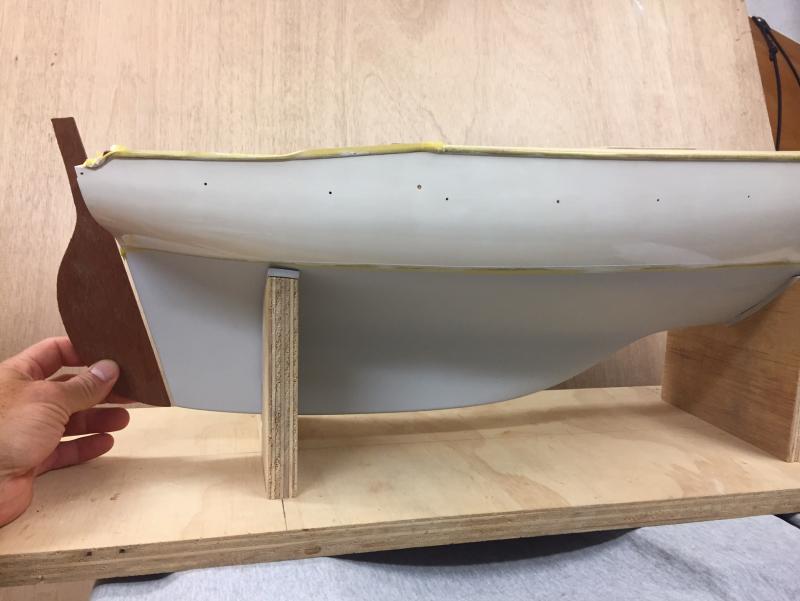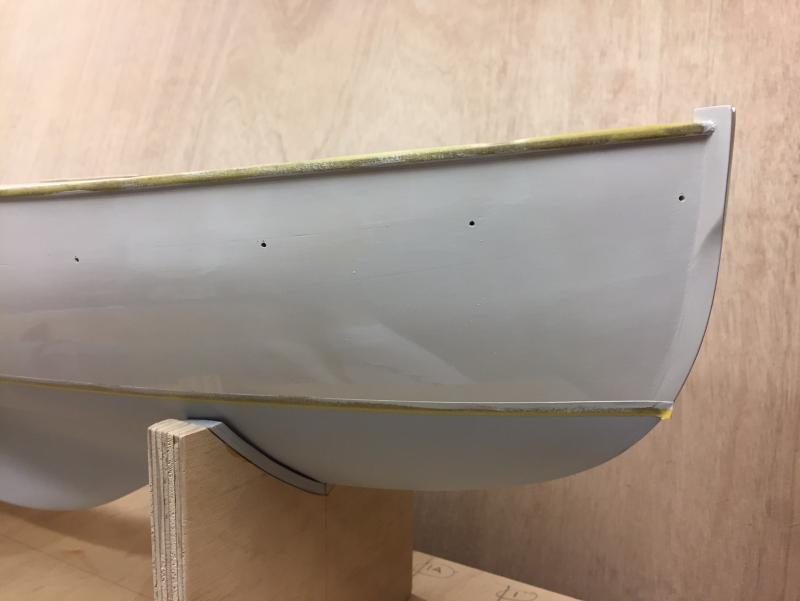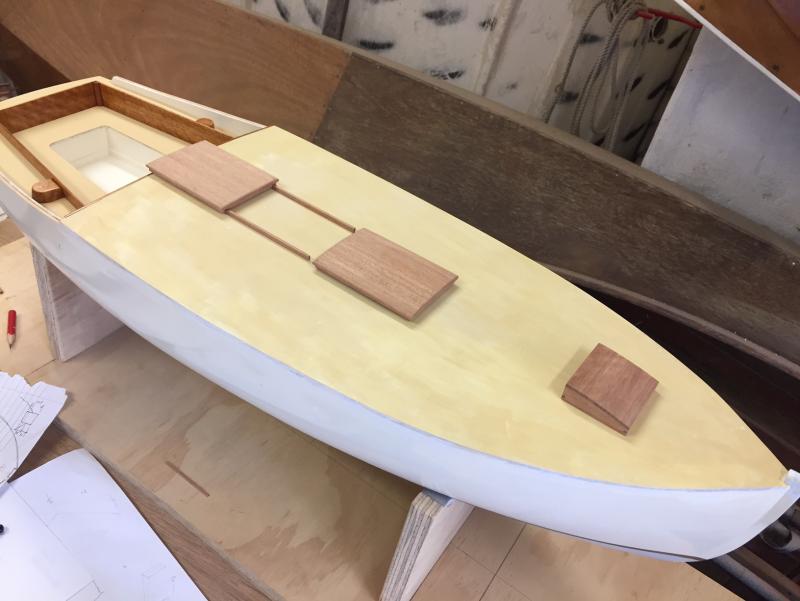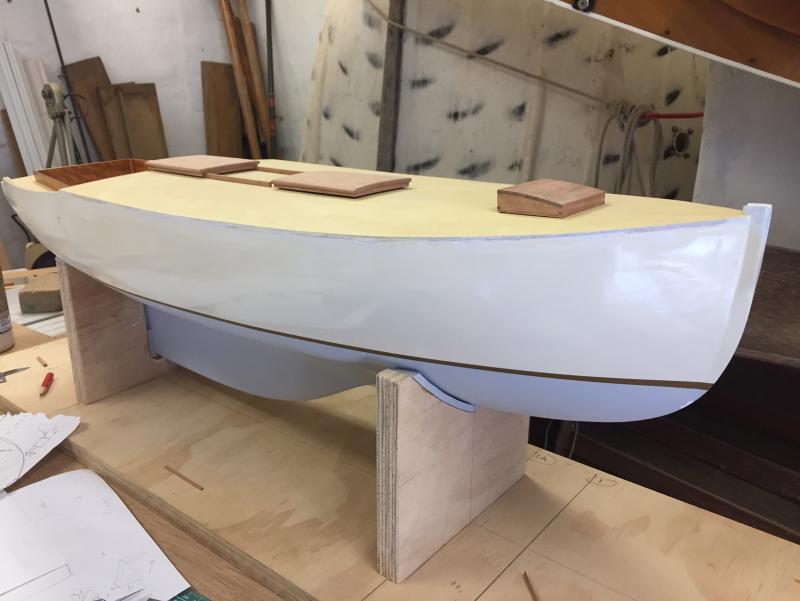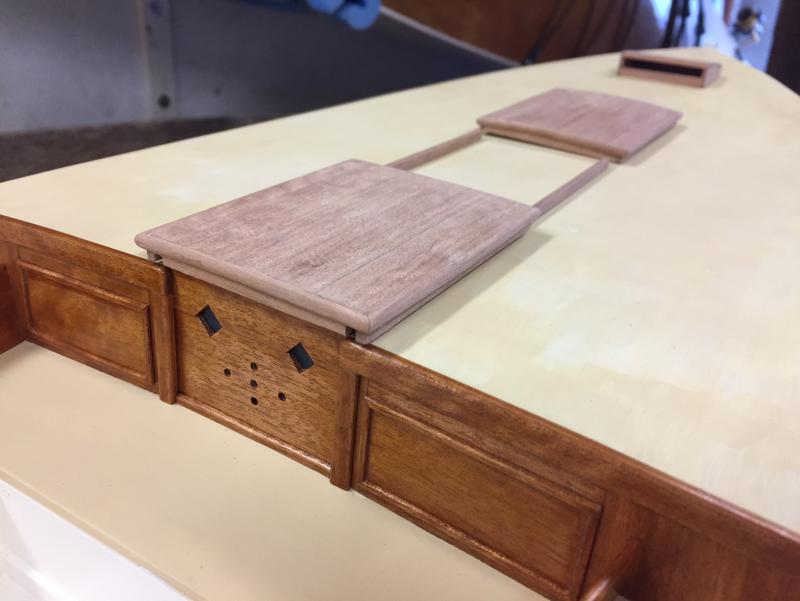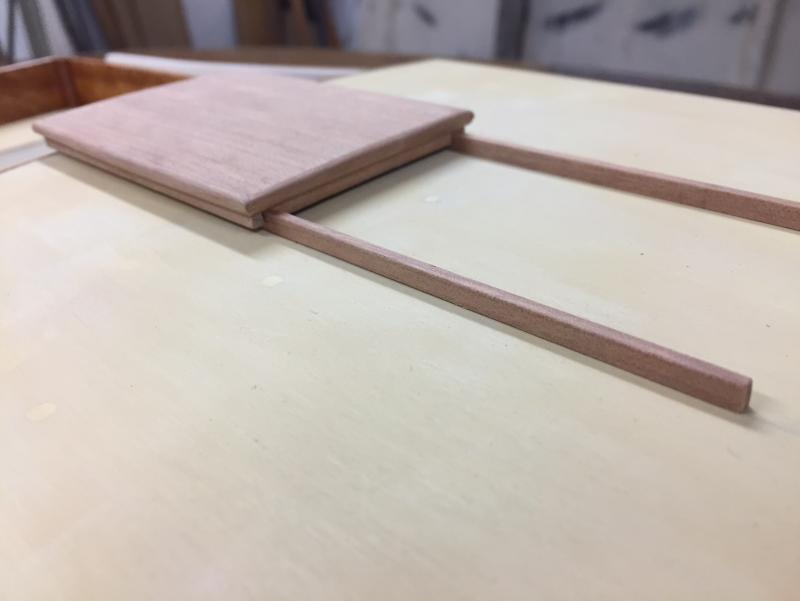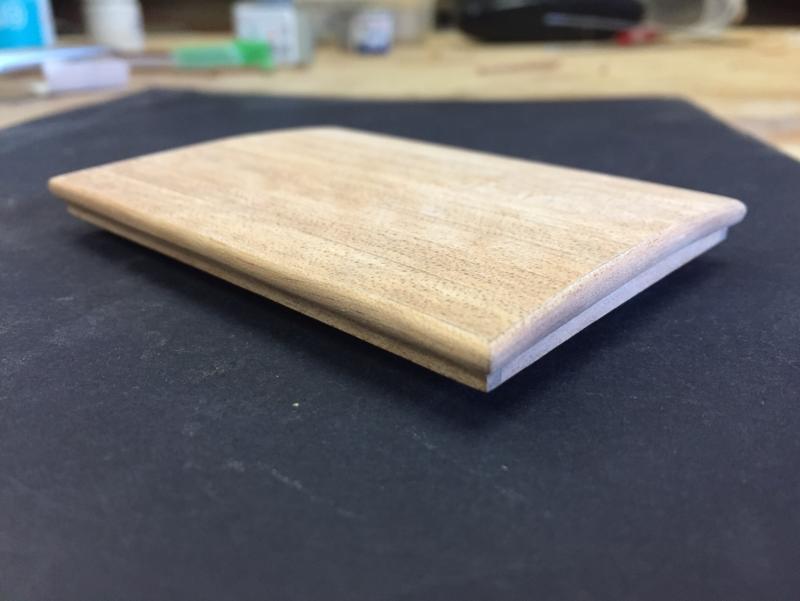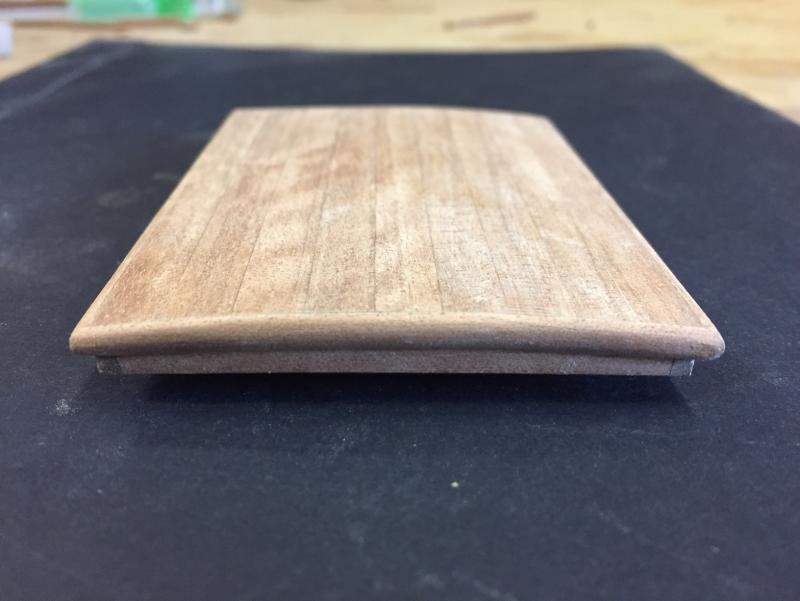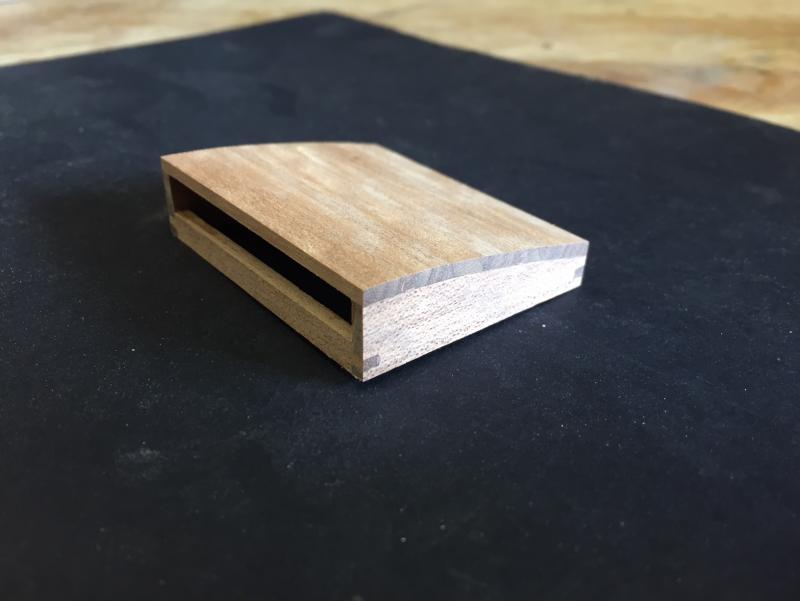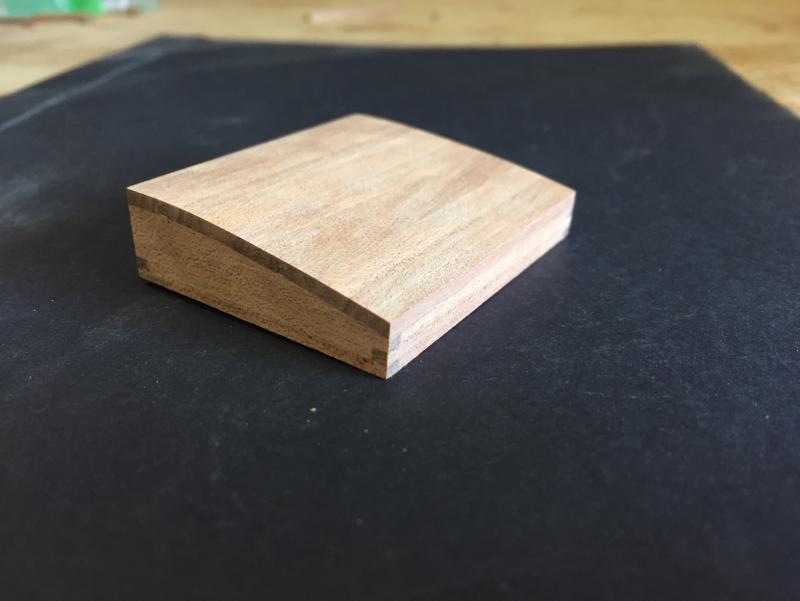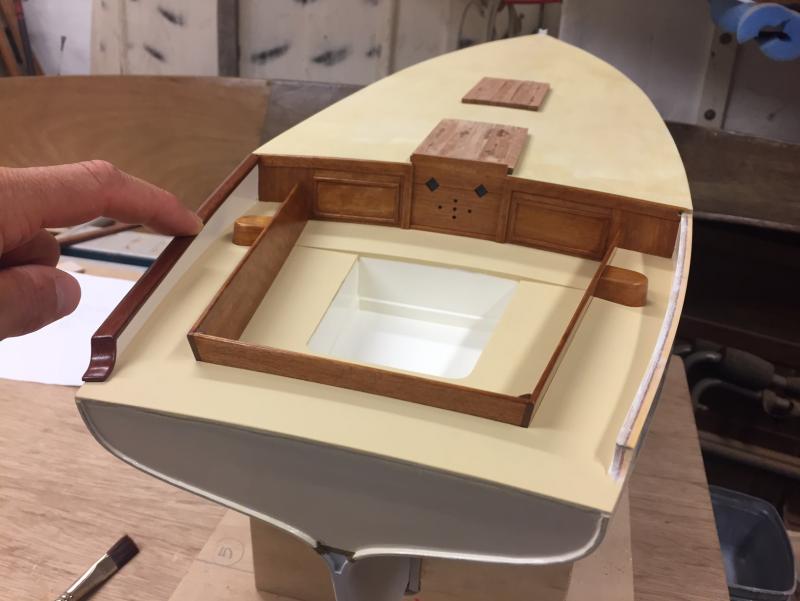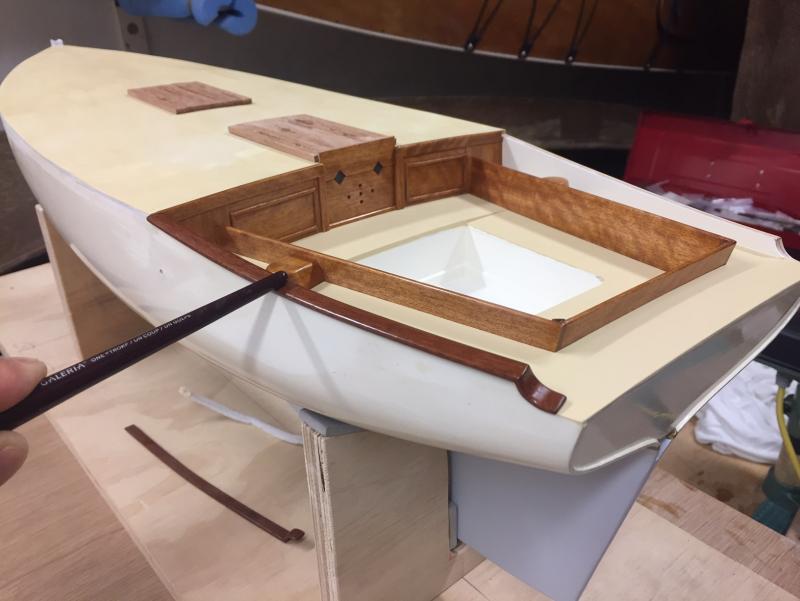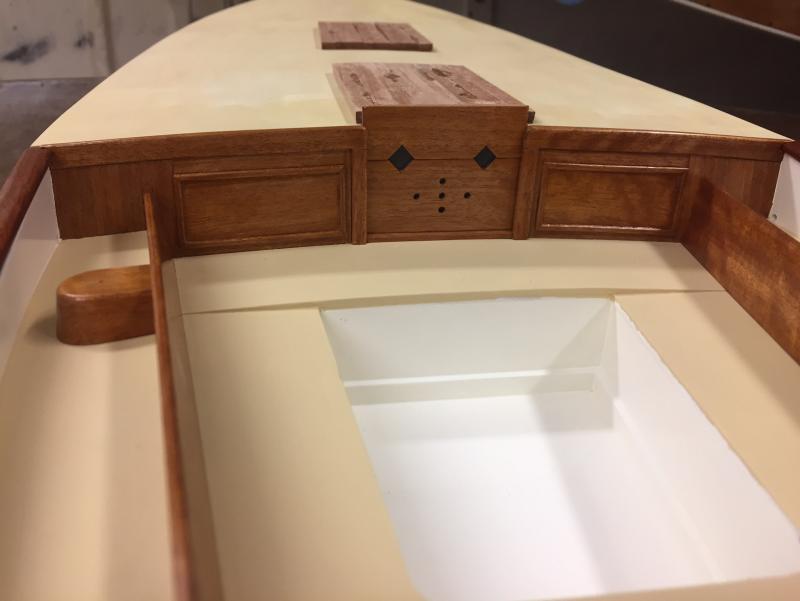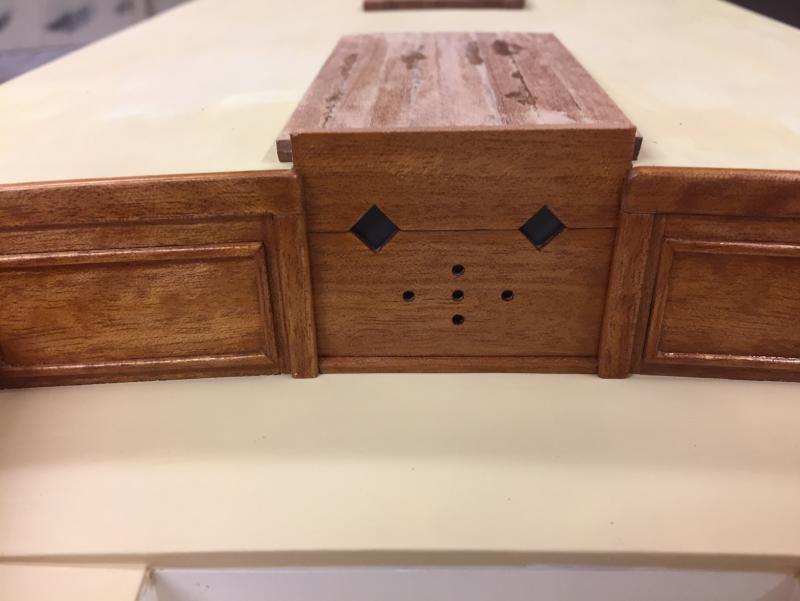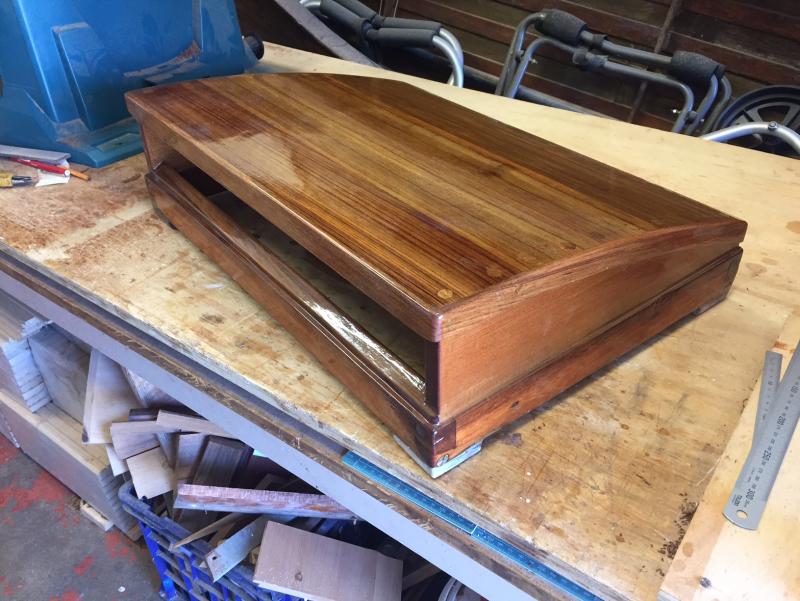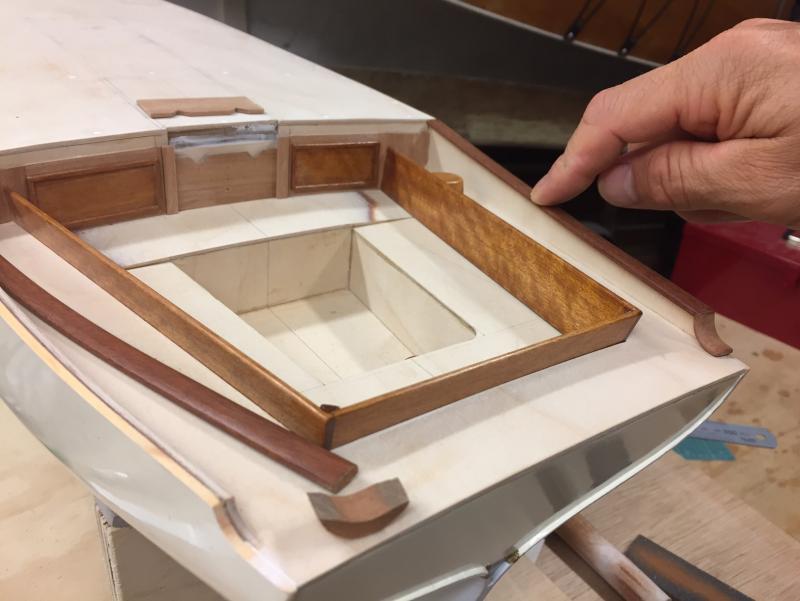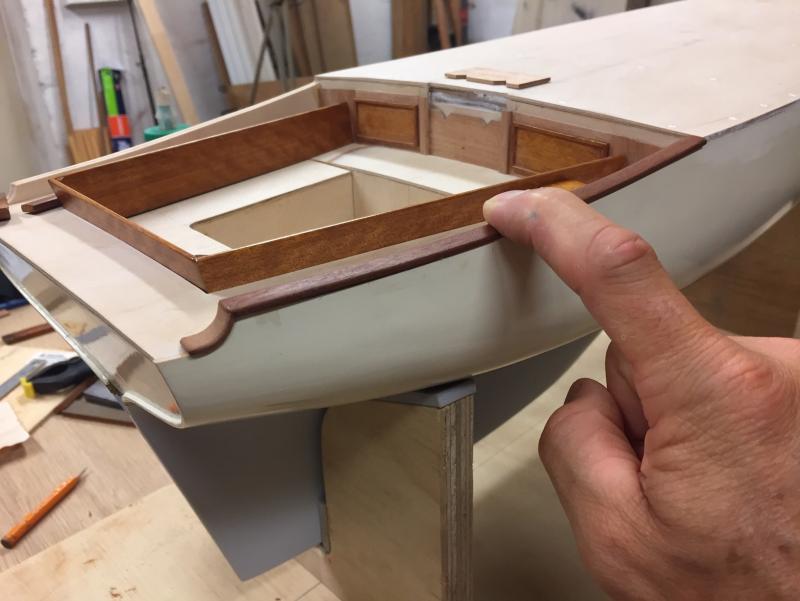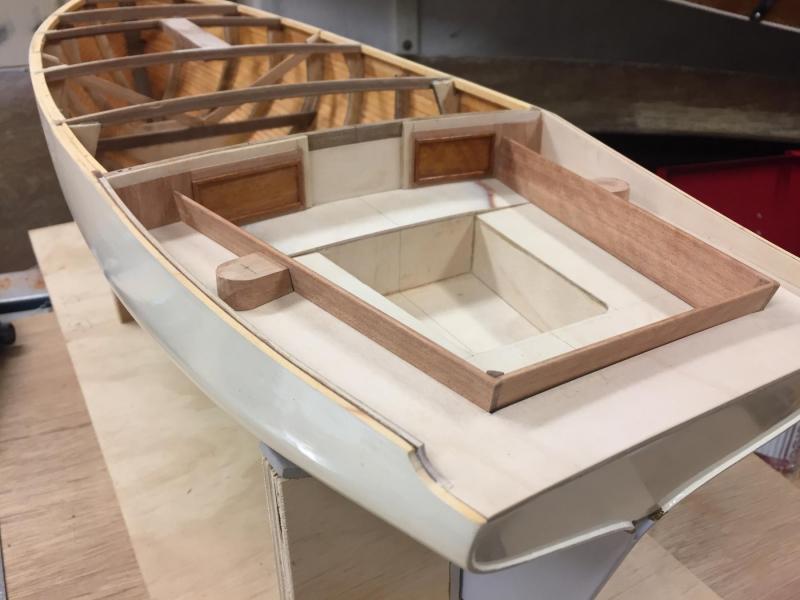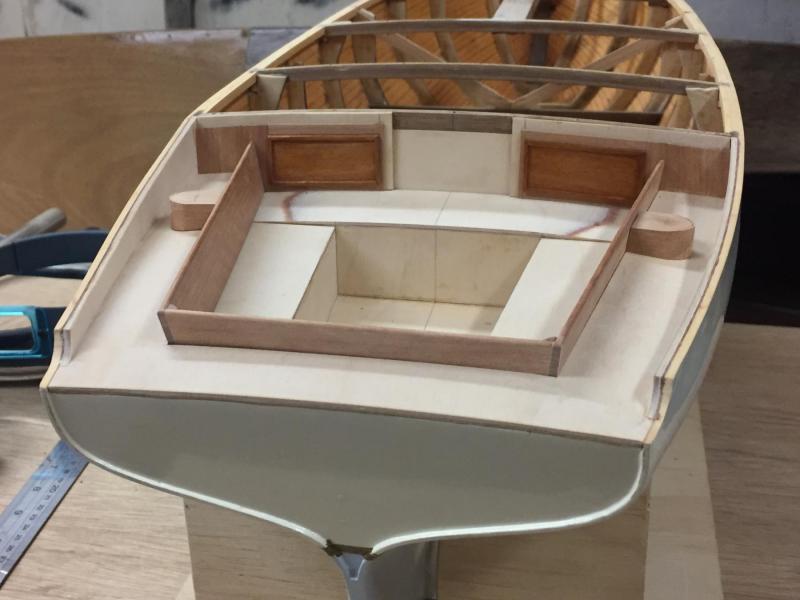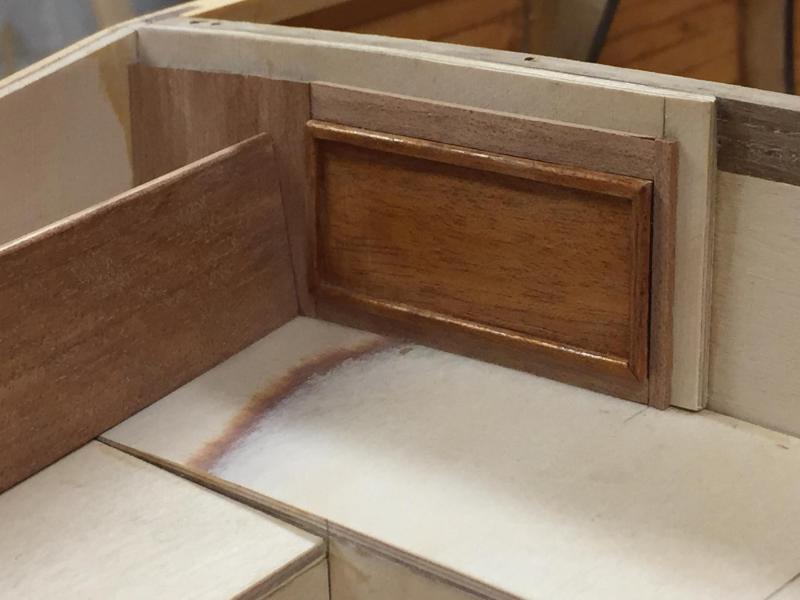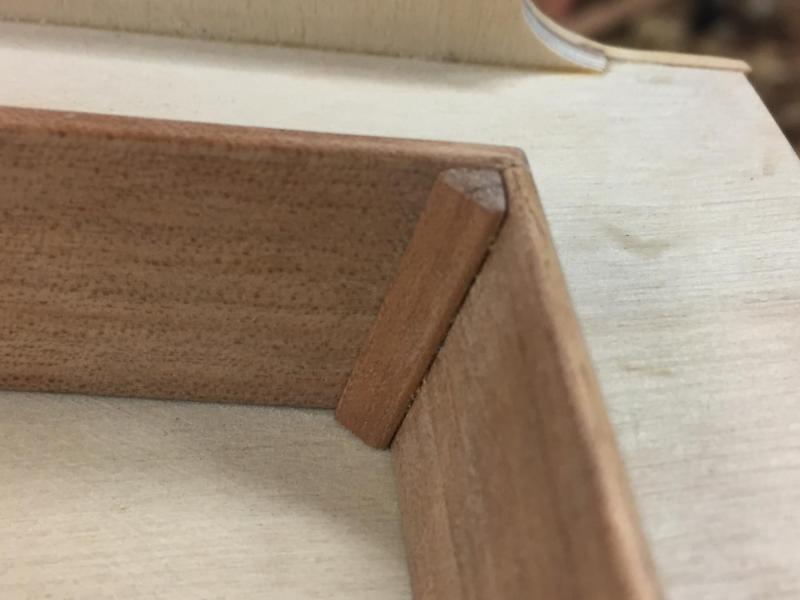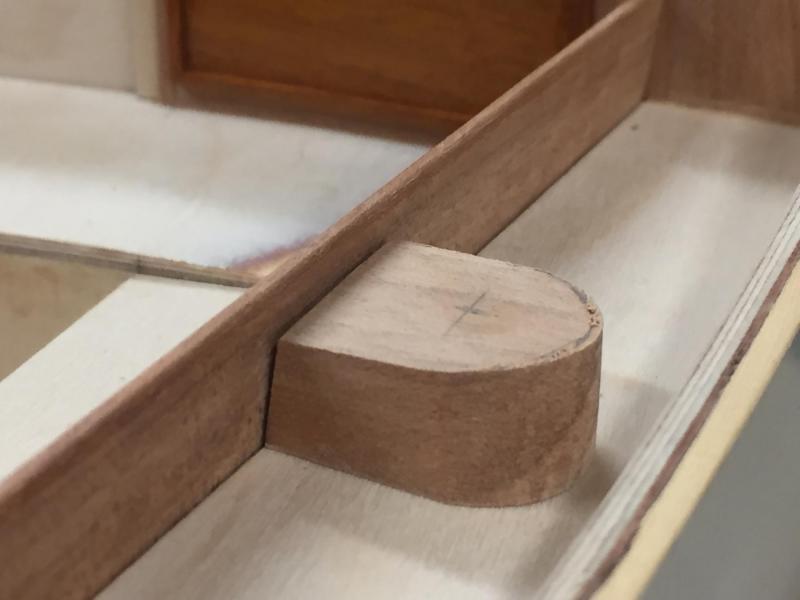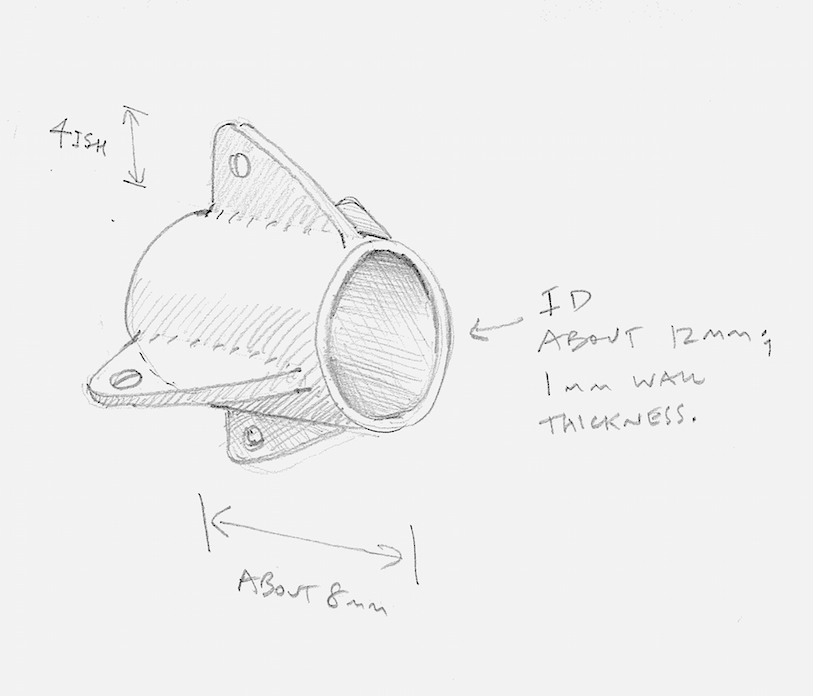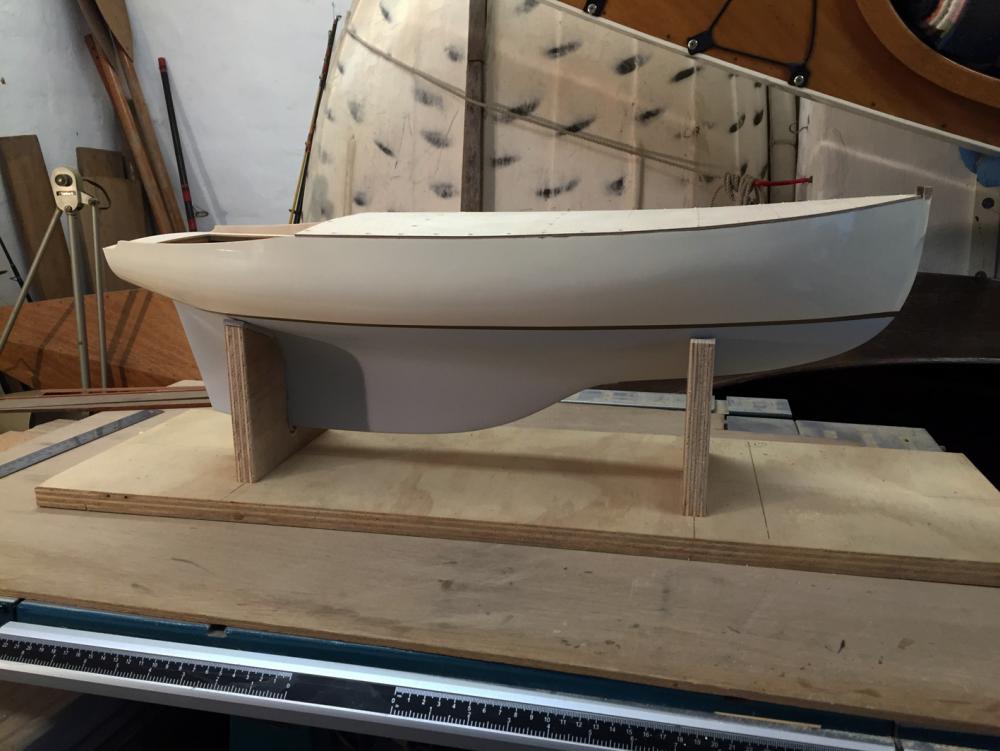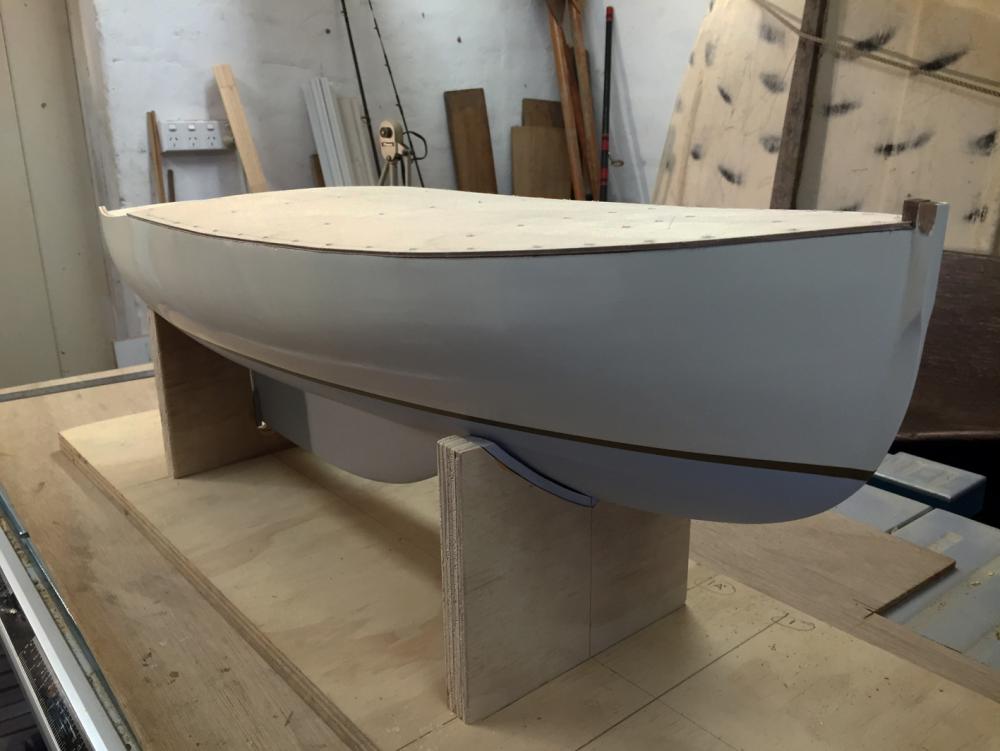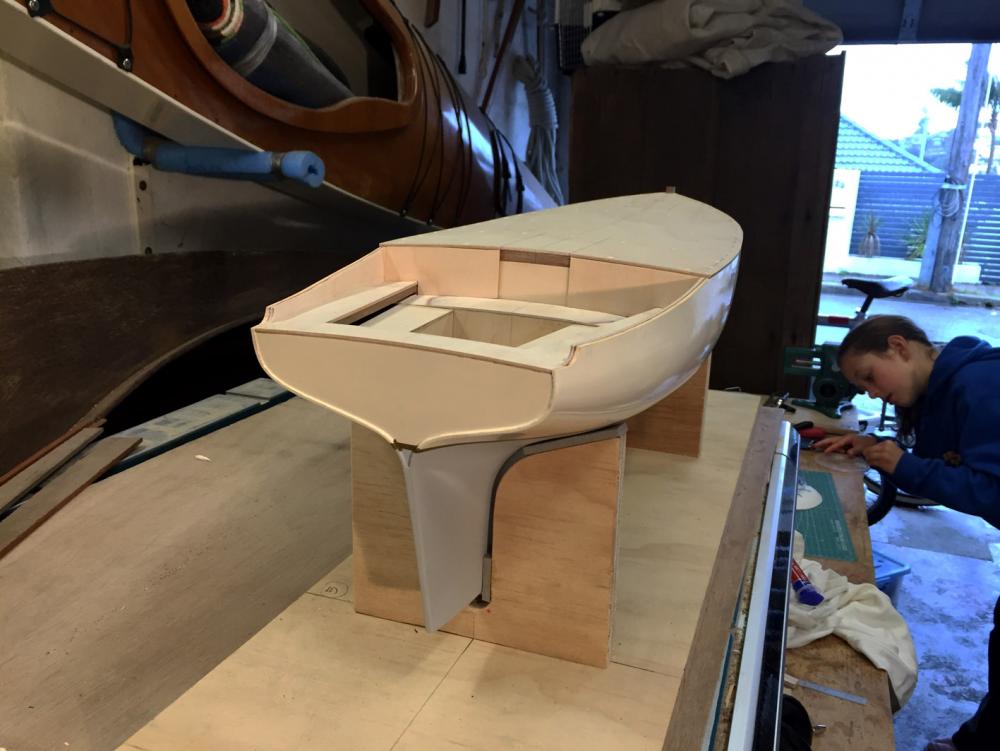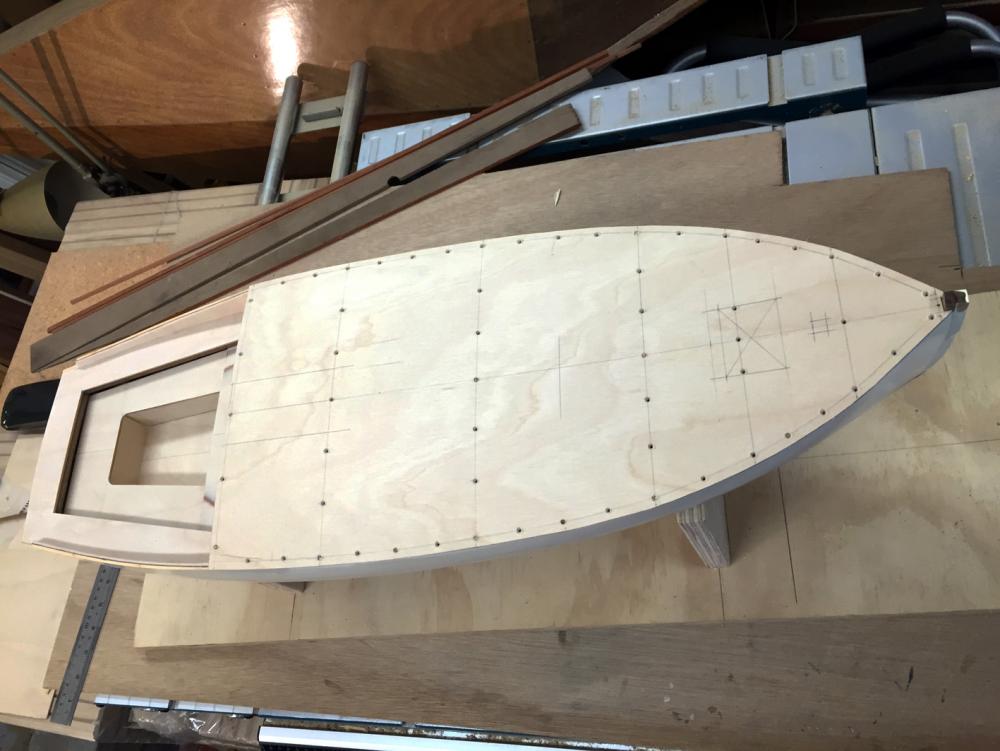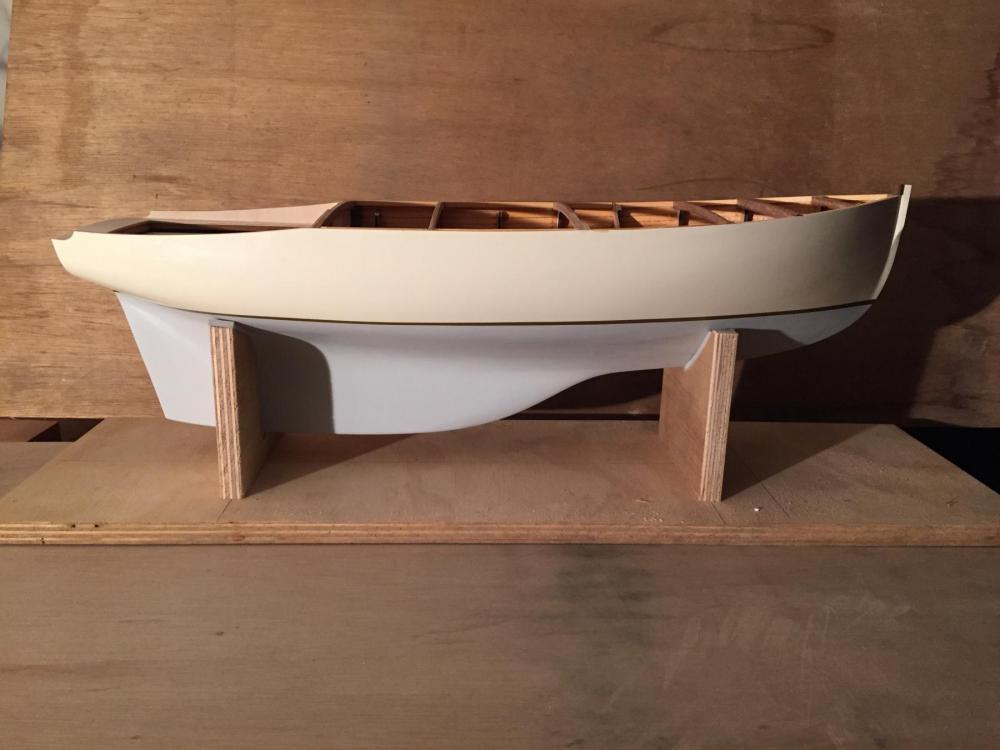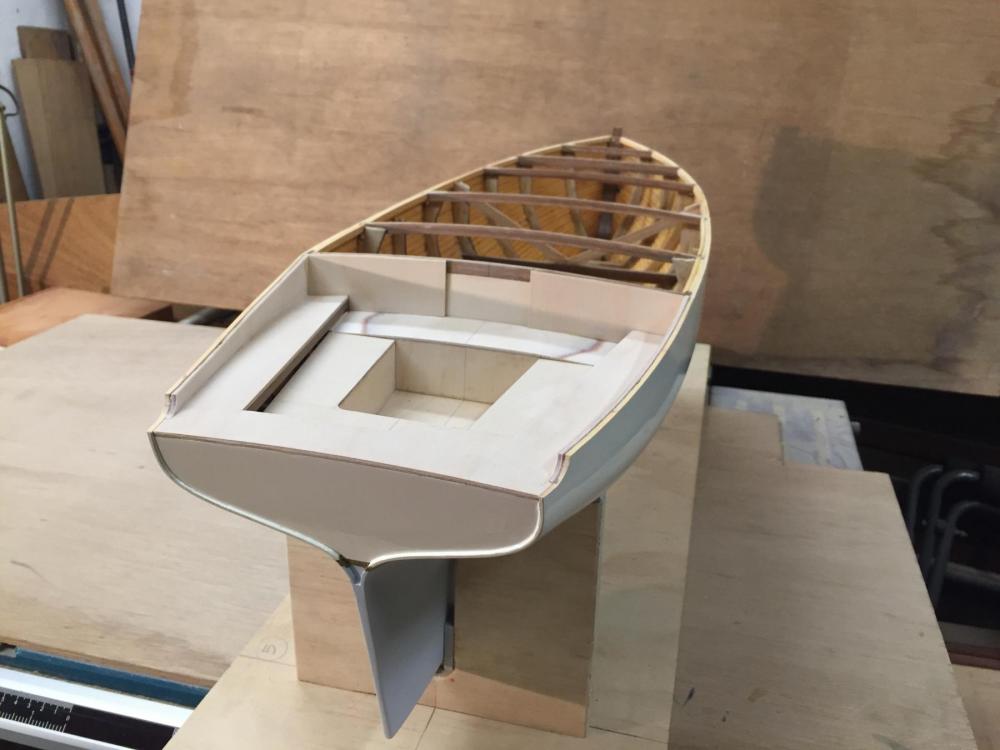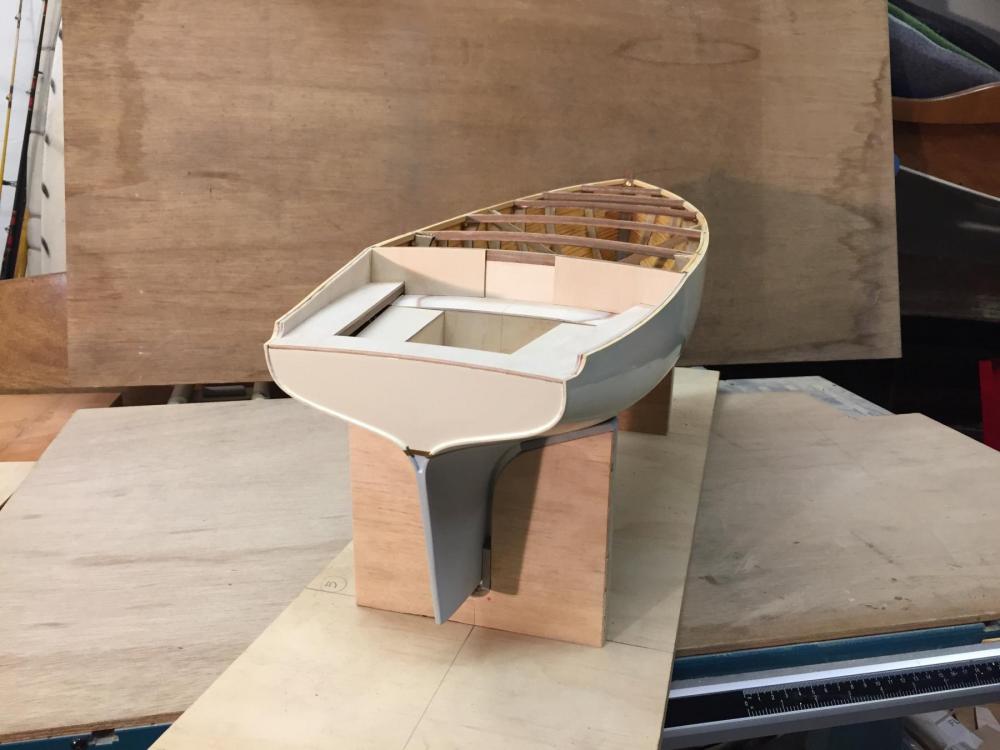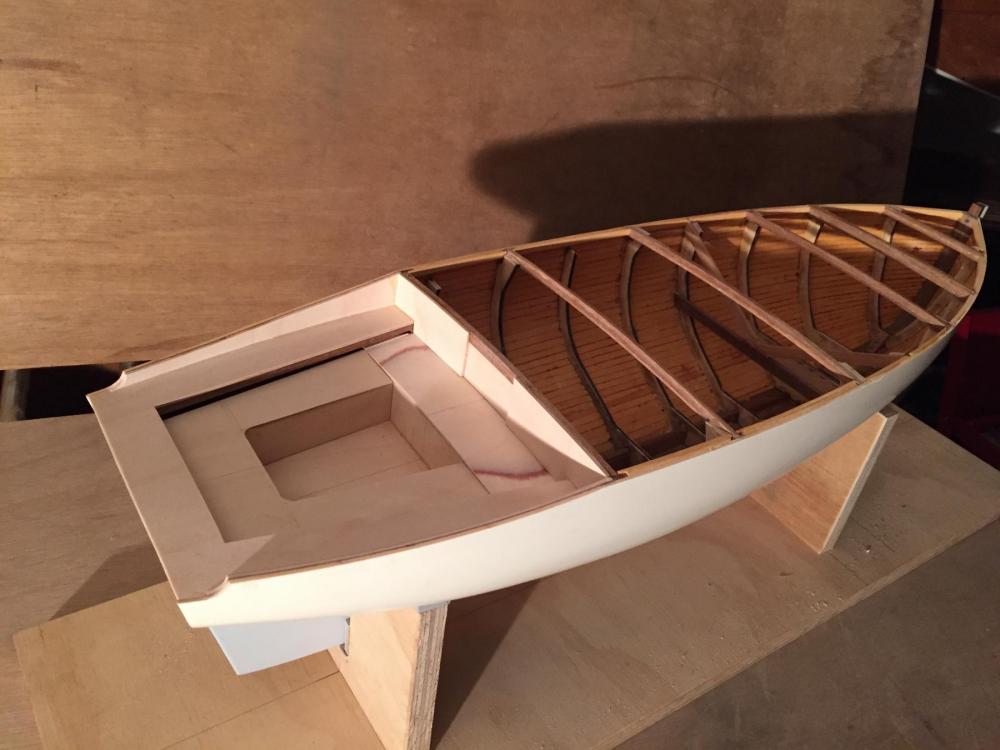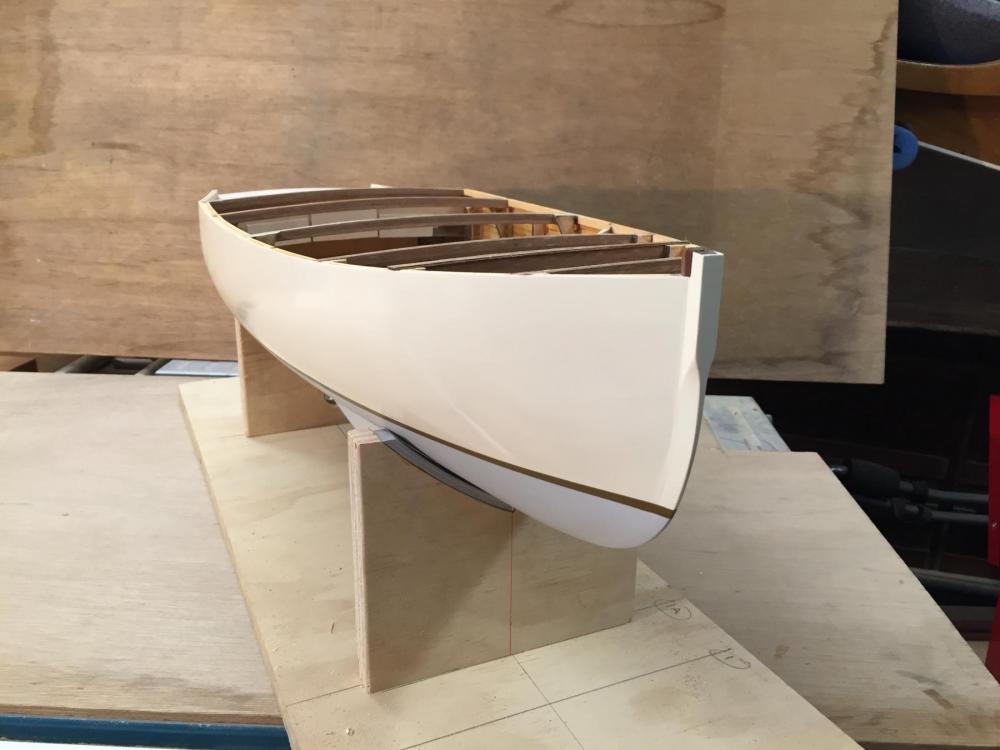-
Posts
820 -
Joined
-
Last visited
Content Type
Profiles
Forums
Gallery
Events
Everything posted by Mark Pearse
-
Back to the work bench again, lots of boating fun over summer... I've started the rudder blade, as below. My understanding is that the designer put a sloping transom on this boat because he didn't like the fine edge of the rudder blade getting damaged by a dinghy, so the concave part of the curve near to the waterline might be altered to fulfil this intention. The careful work of setting out the sponsons is underway; it's possibly the most challenging visual thing to get right on the design; the gunwales line give one curve, & the sponson line is in balance with that. The setout was done by wrapping the hull in about 6 large rubber bands & sliding the sponson strips underneath the bands. When I was happy I put a pencil line on the hull topsides. To help with accurate installation, I made some small studs that temporarily sat in drilled holes in the back of the sponsor strips. The positions were marked by pressing against the hull; the studs were replaced with brass rod that will help hold the strips in a stable position while the glue goes off. studs drilled holes in hull, repainting underway sponsons with rods; also the 'teak' colour of the hatches went ok
-
Hi John this has been great to watch, she is a beautiful & delicate model, & must have been a very pretty boat. Mark
- 745 replies
-
- francis pritt
- mission ship
-
(and 1 more)
Tagged with:
-
The hatches have progressed & are almost complete. They are just sitting in place & no finish as yet. I'd like to show a more teak colour than the other timber is, so I'll try putting a touch of black ink into the shellac - or perhaps a light watercolour wash on the timber before the shellac. The companionway hatch is a simplified version of a simple mechanism & not much detail is shown, it is intended to be a very simple system anyway, similar to some that I have seen. I may show a brass flat bar on the top of the timber rails, but my metalwork has yet to be tested so we'll have to see about that. The decision will partly depend on the balance of detail on the model - The curved beading at the ends was heated with a heat gun while I gently bent them with my fingers. A few cracked beads & lightly smoking fingertips, but when it worked they took only a few minutes. The timber is fairly brittle. The main hatch might get some lights set into it, I'll decide that later, but fixed round lights would be a nice touch. The fore hatch is ventilating, it's not quite completed, I will probably put a simple beading to the edge, similar to the others but probably a bit finer to suit the smaller size. The implied dovetails are just cut square & not bevelled, I felt that in this case showing some construction detail was important to give a sense of how the timberwork would be put together. thanks, good wishes for the Christmas season everyone.
-
Hi Vaddoc, your boat is looking very nice. I'm really new to this hobby, & one part of me is wary about giving advice when I'm not experienced, but it was from a friend that knows about boats & was useful for me at the same stage you are at - he said that if you can see the hull the right way up (i.e.: not upside down), & you can better judge how well the battens are lined off (assuming the battens are the future planking lines). It helped me; so I suppose that we are better at seeing a nice planking setout than we realise, we've all looked at a lot of photos & something must have sunk in. Mark
-
Most of the finished raised deck cockpit parts have been installed. I'm happy with the shellac finish on the timber, about 8 coats well sanded, the final one with steel wool; & finally a thin coat of clear polyurethane finish was wiped on with a cloth to give satin finish, slightly glossy. The deck in the cockpit area has been painted with the final colour, a matt cream colour. The edge of the seating footwell will be trimmed in timber, where the colour changes from cream to white. The side rectangular panels are removable in the design, hence their beaded edging. The storm boards are simple, true to the intention that the boat was used mainly for the harbour & some short coastal trips. I've left the top part over-height to be trimmed down later. The 2 main deck hatches are started, I'll stain the timber a colour to replicate teak. The hatch details will be simple, a lot of boats here of that time had fairly poor hatches - I suppose that if it doesn't get too cold then it doesn't matter so much if it leaks air. The capping pieces are not glued on yet, I may wait until after the topsides are repainted first, to be decided. thanks
-
Yet another hiatus from the model, this time it was to rebuild a 1:1 hatch into a ventilating one. It's no lightweight, but neither is the boat. I've been working on the capping pieces that trim off the topsides besides the cockpit. Visually incredibly important for this boat, so it's nice to have completed one side. Some of the timber has some shellac on it, & the raised deck step has some more pieces done or underway - storm boards & the vertical frames either side. thanks, Mark
-
I've started doing the timber work details, initially in the cockpit area & probably move on to the deck & the topsides timber work last. I'm using some Queensland Maple for most of it, ripped into strips of various thicknesses. The finish will be shellac, it's versatile, quick & the finish is good when it's finally rubbed with some steel wool. I've noticed that a full gloss finish is glossier when you are close to it than when you are further away, so I reason that to "scale" a gloss level, it should be reduced from full gloss to match the scale of the distance. So, there won't be full gloss on the model even though the varnish would be full gloss in reality. Not having done this before, I'm being cautious & will make as many parts as I can without installing them, to do the shellac finishing separately & then glue them in after paintwork has been done. For the timber to be glued in & then finished insitu, I'll be as careful as I can & let the paint go over any shellac on the wrong areas. The seat backrests, hatch panels, winch bases are just sitting there loose. The removable hatches have a few coats of shellac to see the colour, they are not glued in yet. The finish has a light sanding. Detail of the seat backrest corner. Winch mounting block underway, the sides will be tapered upwards. thanks for looking, bye for now MP
-
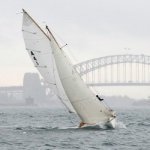
34ft Danish Cutter by adamdt
Mark Pearse replied to adamdt's topic in - Build logs for subjects built 1901 - Present Day
looks great Adam, Mark -
Well done on the award. That's very enjoyable to look through - really great work & a work of art. (from another Jaws fan, an underrated film) thanks for showing it off Mark
-
Hi John I've got a couple of ideas on the spreaders: do you think it's possible they ran a line to the mast head & used a boom as an occasional crane for loading? Another possibility is to do with the gaff - the peak halyard would run from the masthead & load the mast to the side a lot of the time - probably all of the time given old canvas sails. It would almost never pull straight aft with much load because as soon as there's some wind the gaff would pivot around the mast, esp given the likely sails. If this hunch is correct, the tip of the mast wouldn't be loaded pulling aft, the real risk of breaking the tip off would be to the side....If the wind was so light that the gaff was sitting more or less straight aft then there would be no need to support the mast tip. best, Mark
- 745 replies
-
- francis pritt
- mission ship
-
(and 1 more)
Tagged with:
-
there is a lot to enjoy in looking at the photos, an interesting design & a lovely model thanks
- 24 replies
-

soldering iron or torch? advice please
Mark Pearse replied to Mark Pearse's topic in Metal Work, Soldering and Metal Fittings
thanks Steve, Allan this has been very helpful -

soldering iron or torch? advice please
Mark Pearse replied to Mark Pearse's topic in Metal Work, Soldering and Metal Fittings
that's huge help everyone, many thanks for your assistance -
I want to make some metalwork parts for the model, & some of the parts have multiple flanges where they probably can't all be attached at the same time. I have't done any soldering or brazing & was wondering if an iron would be better if there's more than one flange to attach...would a torch tend to soften any joints already done? thanks, below shows one of the parts
-

34ft Danish Cutter by adamdt
Mark Pearse replied to adamdt's topic in - Build logs for subjects built 1901 - Present Day
lovely lines Adam, but maybe check the keel thickness, it looks very thin. best, Mark -
Hi Jon looks great, well done. I think the lee helm is because your clew is very loose to the boom & not at the boom where it should be, you can see that the main is not getting much of it's potential power whereas the jib is. I might be wrong, but is the clew on the full sized boats tight to the boom (or a bit loose when it's light)? This would have the effect that Bob describes Mark
-
I've cut the deck & in the photos it is temporarily fitted with small screws. The screw heads will be filled over, but the 2-way deck curve needs more than just a little clamping. Some of the deck parts have been pencilled on, but there's still some thinking to do: review the mast position again. It's not going to have to sail, but if the mast setout looks wrong it'll really bug me, it's looking a little too far forward, but the bowsprit isn't on yet. A long bowsprit looks nice, but I'm assuming a hanked jib luff, so it puts some emphasis on actually being able to reach the forestay without drama. Sometimes they put a wide rectangular bowsprit so that stepping on it was easier, & it also meant that whisker stays were not necessary, which makes using an anchor a bit simpler. If I put on whisker stays I will good to put the whisker chain plates on before the deck. I'm thinking to deck step the mast, it doesn't really make sense to put it to the keel step it now. What's next: mast / whisker chainplates, finish setting out the decks, glue the deck & fit the gunwales & sponsons. thanks for the interest
-
Hi there, I've not done what you are asking about, but I would definitely recommend a test run - I have done fibreglass & epoxy sheathing on a full sized sailing boat & I wish that I'd practised first. You (probably) can't take it off, you might only learn what thickness would be right after having done it. good luck with it,
-
thank you Patrick I wasn't planning to do the interior fitout, & I say that somewhat sheepishly having seen the detailed interior fitouts that you do. But I have planned the interior in my head - 2 full bunks forward, with a 4' zone with a wet locker or heads one side & a 4' galley the other side, then 2 full bunks that doubles as a saloon. Nils & Michael, thanks. I am always interested in how the subtle details change the way a boat's hull looks. In this case having multiple curved horizontal lines, working in balance will be even more interesting. The same hull can look very different with fairly minor visual differences.
-
thanks all, I've lined off the cockpit area in some lovely Finnish 2mm ply, it will all be painted. The varnished timber details will be added after painting, & haven't been made yet. The deck beams are in, spaced to suit the model not a real yacht, the interior will be enclosed & not visible. The V beam you can see is because the mast position would intersect that beam, & the rake is sufficient for the base of the mast to miss the lower part of the V. It will ensure that the hull width doesn't move while I'm making it. You can see that I had to sand the thwart that is immediately aft of the raised deck, after massing it up I realised that it would have had a step in the underside edge varnished seat backrest, which wouldn't look so good. The deck will go on soon, the deck fittings won't need backing as they won't be functional. thanks
About us
Modelshipworld - Advancing Ship Modeling through Research
SSL Secured
Your security is important for us so this Website is SSL-Secured
NRG Mailing Address
Nautical Research Guild
237 South Lincoln Street
Westmont IL, 60559-1917
Model Ship World ® and the MSW logo are Registered Trademarks, and belong to the Nautical Research Guild (United States Patent and Trademark Office: No. 6,929,264 & No. 6,929,274, registered Dec. 20, 2022)
Helpful Links
About the NRG
If you enjoy building ship models that are historically accurate as well as beautiful, then The Nautical Research Guild (NRG) is just right for you.
The Guild is a non-profit educational organization whose mission is to “Advance Ship Modeling Through Research”. We provide support to our members in their efforts to raise the quality of their model ships.
The Nautical Research Guild has published our world-renowned quarterly magazine, The Nautical Research Journal, since 1955. The pages of the Journal are full of articles by accomplished ship modelers who show you how they create those exquisite details on their models, and by maritime historians who show you the correct details to build. The Journal is available in both print and digital editions. Go to the NRG web site (www.thenrg.org) to download a complimentary digital copy of the Journal. The NRG also publishes plan sets, books and compilations of back issues of the Journal and the former Ships in Scale and Model Ship Builder magazines.



